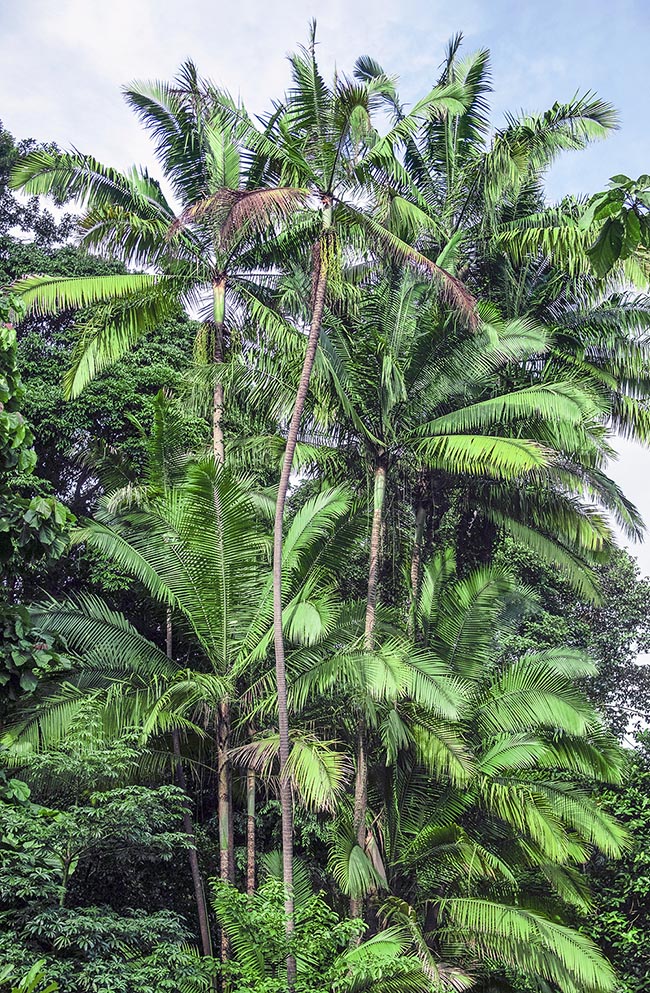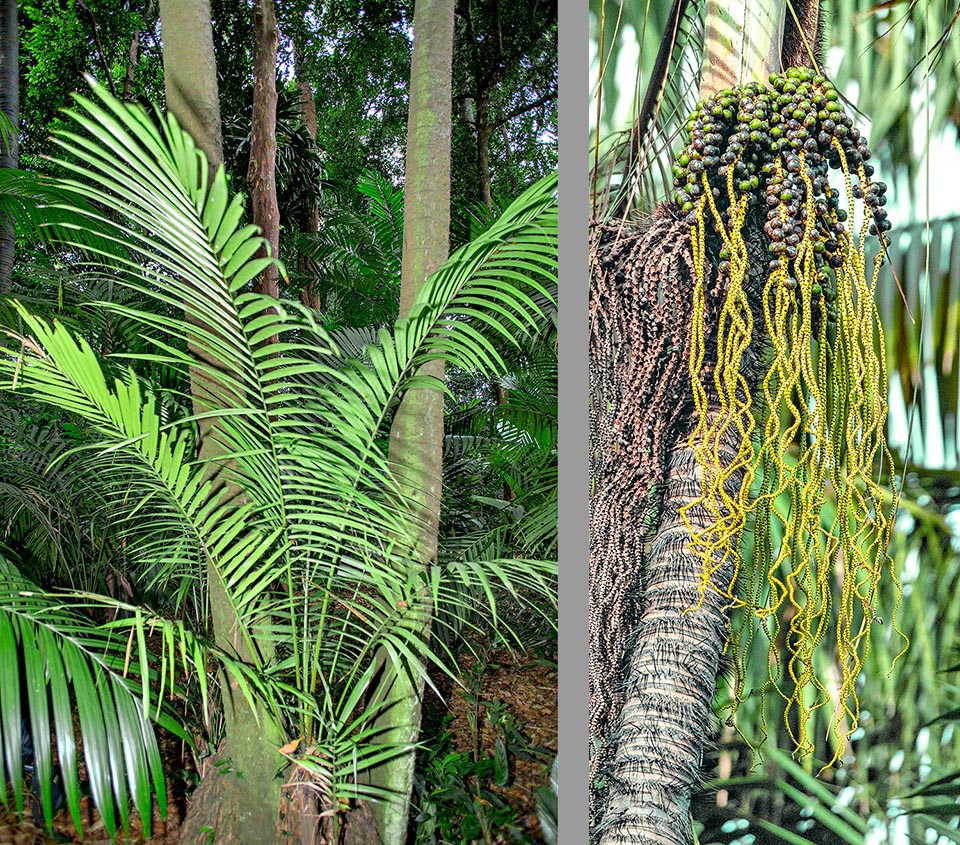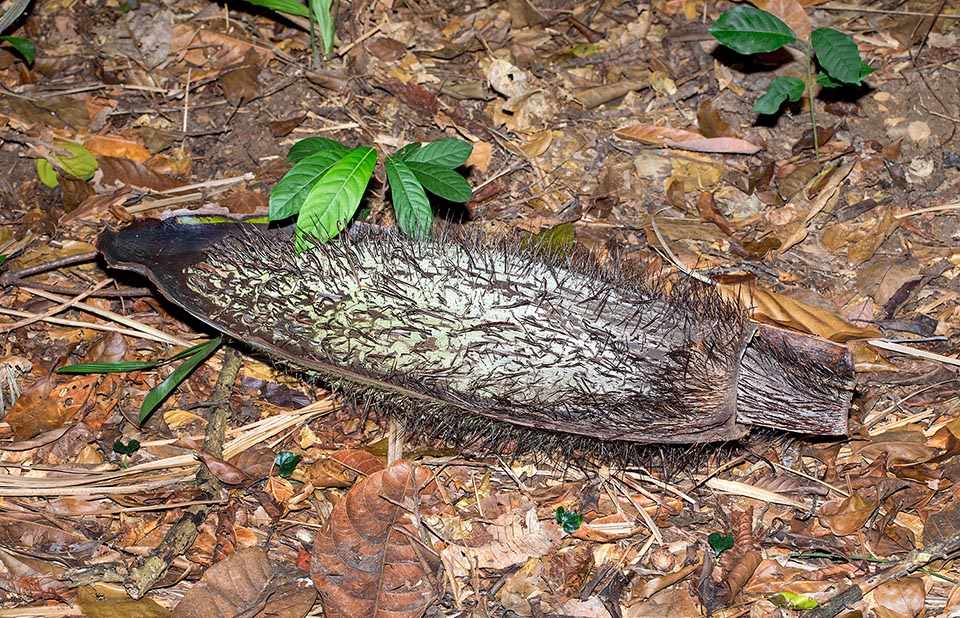Family : Arecaceae

Text © Alessandro Marini

English translation by Mario Beltramini

Very diffused in south-east Asian rain forests, Oncosperma horridum can be 20 m tall © Zaki Jamil
Oncosperma horridum (Griff.) Scheff. is a monoecious species that has a vast distribution range in South-East Asia, where it can be found in Thailand, Malaysia, Borneo, Philippines, Sulawesi and Sumatra. It grows in the plain rain forests up to the mountain slopes at altitudes of 1.000 m.
The name of the genus Oncosperma comes from the Greek epithets “ὄγκος (oncos)mass, and “σπέρμα” (spérma), semen, and refers to the surface of the seeds of the plant. The name of the species horridum comes from the Latin “horridus”, bristling, shaggy, with reference to the dangerous thorns present in the palm.
Common names: Bayas (Malay); Nibong (Indonesian); Lao cha on khao (thai); Mountani Nibong palm, Thorny palm (English); Ba ya ye zi (Chinese)
Oncosperma horridum is a multi stemmed species, often even solitary, that can form tufts of 4-10 thin erect stems reaching the height of 30 m and the diametre of 25 cm, towering over the trees of the tropical forest.
The grey stems are covered by black acuminate thorns facing down, up to 10 cm long, and are marked by brown rings in correspondence to the bases of the fallen leaves.
The large crown is formed by pinnate leaves, slightly arcuate, even more than 3 m long. The bright green pointed pinnulae are uniformly arranged on the sides of the rachis on only one level, slightly drooping, up to 50 cm long and 3 cm broad.
The leaves are carried by dark thorny petioles up to 1 m long ending in a green-grey sheath wrapping completely the trunk, up to 1 m long, thorny too.
The great yellow inflorescences come out under the sheath in correspondence to the rings on the stem and are ramified and thorny, up to 60 cm long. Initially, they are enclosed in a grey spathe, deciduous and very thorny. They display flowers distributed spirally all over the length, arranged in triads formed by two male flowers and one female.
The fruits are oval, waxy, initially of green colour, then brown and finally black when ripe, with 1,5-2 cm of diametre. It reproduces by seed that germinates in less than 2 months, previously immersed in lukewarm water for 24 hours and then put in a container on a warm bed at the temperature of 28 °C.
Oncosperma horridum is very similar to the congener Oncosperma tigillarium, more known in cultivation, from which can be distinguished because it forms tufts with few stems or even with a solitary stem, as well as for the bigger leaves that display almost plain pinnulae, instead than elegantly drooping as in Oncosperma tigillarium.

It is a solitary or multistemmed palm, as is noted, links, on new growing stem. Right, close-up of showy rachis full of fruits and of the very thorny stem © Giuseppe Mazza and Zaki Jamil
Oncosperma horridum is a very ornamental palm that is not frequently diffused out of South-East Asia, also because in cultivation is preferred Oncosperma tigillarium due to its better aesthetic qualities.
The presence of the dangerous thorns on the whole plant must be well kept in mind when it is thought to utilize it in parks and gardens. It can be cultivated only in tropical or warm subtropical climates, considering that the exposition to temperatures included between 5 °C and 10 °C can cause damage and even death to the plant. It needs a lot of environmental humidity and becomes marginal in the zones where the rains in the driest month cannot even reach 25 mm.
It is a very fast growing species and adapts to any type of soil but prefers the humid ones, well drained, with easy access to water. The exposition must be in full sun, even if, when young, it is better to keep it in partial shade. It is very resistant to saltiness and to brackish water.

Also the spathe of Oncosperma horridum, here on the soil, is very thorny. The apical bud is edible, the leaves are intertwined to make baskets and serve for house coverage. The elastic stems, very resistant to saltiness and rotting, are locally used to build boats and “kelungs”, wooden structures on the sea to farm or catch fish © Giuseppe Mazza
Oncosperma horridum is particularly appreciated in its origin area due to its edible apical bud, utilized in various ways in the local cuisine. The leaves are intertwined to realize baskets and other objects and are utilized for the covering of the habitations.
The robust but elastic stems are employed in the construction of the houses, as foundation and as flooring, and are preferred to those of other plants due to their long duration. Thanks to the resistance to the saltiness and to the rotting, they are utilized in constructing the kelungs, wooden structures on the sea for farming or catching the fish and also for constructing boats.
The status of conservation of this species has not yet been verified by the International Union for the Conservation of Nature (IUCN). This species is considered as vulnerable in some sites of the distribution area, whilst is present only in the protected zones.
Synonyms: Areca horrida Griff.; Oncosperma horrida (Griff.) Scheff.
